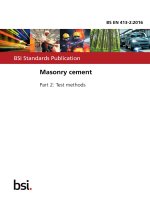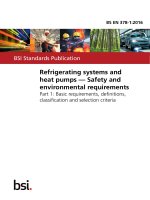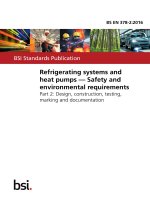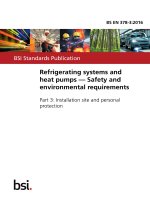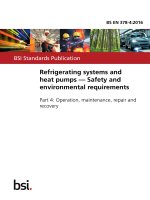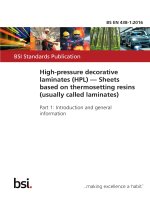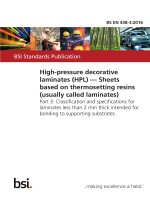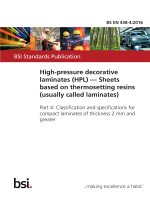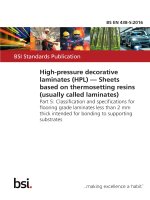Bsi bs en 62047 25 2016
Bạn đang xem bản rút gọn của tài liệu. Xem và tải ngay bản đầy đủ của tài liệu tại đây (2.65 MB, 28 trang )
BS EN 62047-25:2016
BSI Standards Publication
Semiconductor devices —
Micro-electromechanical
devices
Part 25: Silicon based MEMS fabrication
technology — Measurement method of
pull-press and shearing strength of micro
bonding area
BRITISH STANDARD
BS EN 62047-25:2016
National foreword
This British Standard is the UK implementation of EN 62047-25:2016. It is
identical to IEC 62047-25:2016.
The UK participation in its preparation was entrusted to Technical
Committee EPL/47, Semiconductors.
A list of organizations represented on this committee can be obtained on
request to its secretary.
This publication does not purport to include all the necessary provisions of
a contract. Users are responsible for its correct application.
© The British Standards Institution 2016.
Published by BSI Standards Limited 2016
ISBN 978 0 580 85615 0
ICS 31.080.99
Compliance with a British Standard cannot confer immunity from
legal obligations.
This British Standard was published under the authority of the
Standards Policy and Strategy Committee on 30 November 2016.
Amendments/corrigenda issued since publication
Date
Text affected
BS EN 62047-25:2016
EUROPEAN STANDARD
EN 62047-25
NORME EUROPÉENNE
EUROPÄISCHE NORM
November 2016
ICS 31.080.99
English Version
Semiconductor devices - Micro-electromechanical devices Part 25: Silicon based MEMS fabrication technology Measurement method of pull-press and shearing strength of
micro bonding area
(IEC 62047-25:2016)
Dispositifs à semiconducteurs - Dispositifs
microélectromécaniques - Partie 25: Technologie de
fabrication de MEMS à base de silicium - Méthode de
mesure de la résistance à la traction-compression et au
cisaillement d'une micro zone de brasure
(IEC 62047-25:2016)
Halbleiterbauelemente - Bauelemente der
Mikrosystemtechnik - Teil 25: Siliziumbasierte MEMSHerstellungstechnologie - Messverfahren zur Zug-Druckund Scherfestigkeit gebondeter Flächen im
Mikrometerbereich
(IEC 62047-25:2016)
This European Standard was approved by CENELEC on 2016-10-03. CENELEC members are bound to comply with the CEN/CENELEC
Internal Regulations which stipulate the conditions for giving this European Standard the status of a national standard without any alteration.
Up-to-date lists and bibliographical references concerning such national standards may be obtained on application to the CEN-CENELEC
Management Centre or to any CENELEC member.
This European Standard exists in three official versions (English, French, German). A version in any other language made by translation
under the responsibility of a CENELEC member into its own language and notified to the CEN-CENELEC Management Centre has the
same status as the official versions.
CENELEC members are the national electrotechnical committees of Austria, Belgium, Bulgaria, Croatia, Cyprus, the Czech Republic,
Denmark, Estonia, Finland, Former Yugoslav Republic of Macedonia, France, Germany, Greece, Hungary, Iceland, Ireland, Italy, Latvia,
Lithuania, Luxembourg, Malta, the Netherlands, Norway, Poland, Portugal, Romania, Slovakia, Slovenia, Spain, Sweden, Switzerland,
Turkey and the United Kingdom.
European Committee for Electrotechnical Standardization
Comité Européen de Normalisation Electrotechnique
Europäisches Komitee für Elektrotechnische Normung
CEN-CENELEC Management Centre: Avenue Marnix 17, B-1000 Brussels
© 2016 CENELEC All rights of exploitation in any form and by any means reserved worldwide for CENELEC Members.
Ref. No. EN 62047-25:2016 E
BS EN 62047-25:2016
EN 62047-25:2016
European foreword
The text of document 47F/249/FDIS, future edition 1 of IEC 62047-25, prepared by SC 47F
“Microelectromechanical systems” of IEC/TC 47 “Semiconductor devices" was submitted to the IECCENELEC parallel vote and approved by CENELEC as EN 62047-25:2016.
The following dates are fixed:
•
latest date by which the document has to be
implemented at national level by
publication of an identical national
standard or by endorsement
(dop)
2017-07-03
•
latest date by which the national
standards conflicting with the
document have to be withdrawn
(dow)
2019-10-03
Attention is drawn to the possibility that some of the elements of this document may be the subject of
patent rights. CENELEC [and/or CEN] shall not be held responsible for identifying any or all such
patent rights.
Endorsement notice
The text of the International Standard IEC 62047-25:2016 was approved by CENELEC as a European
Standard without any modification.
2
BS EN 62047-25:2016
EN 62047-25:2016
Annex ZA
(normative)
Normative references to international publications
with their corresponding European publications
The following documents, in whole or in part, are normatively referenced in this document and are
indispensable for its application. For dated references, only the edition cited applies. For undated
references, the latest edition of the referenced document (including any amendments) applies.
NOTE 1 When an International Publication has been modified by common modifications, indicated by (mod), the relevant
EN/HD applies.
NOTE 2 Up-to-date information on the latest versions of the European Standards listed in this annex is available here:
www.cenelec.eu
Publication
Year
Title
EN/HD
Year
IEC 62047-1
-
Semiconductor devices - Microelectromechanical devices Part 1: Terms and definitions
EN 62047-1
-
ISO 10012
-
Measurement management systems EN ISO 10012
Requirements for measurement processes
and measuring equipment
-
3
–2–
BS EN 62047-25:2016
IEC 62047-25:2016 © IEC 2016
CONTENTS
FOREWORD ......................................................................................................................... 4
1
Scope ............................................................................................................................ 6
2
Normative references..................................................................................................... 6
3
Terms and definitions .................................................................................................... 6
4
Requirements ................................................................................................................ 7
4.1
Testing structure design requirements ................................................................... 7
4.2
Testing structure fabrication requirements ............................................................. 9
4.3
Testing environment requirements ......................................................................... 9
5
Testing method .............................................................................................................. 9
5.1
General ................................................................................................................. 9
5.2
Pull-press testing method ...................................................................................... 9
5.2.1
Imposing the loading force ............................................................................. 9
5.2.2
Pull-press testing method operation process ................................................... 9
5.2.3
Pull-press testing method result process ....................................................... 10
5.3
Shearing testing method ...................................................................................... 10
5.3.1
Shearing testing method operation process .................................................. 10
5.3.2
Shearing testing method result process ........................................................ 12
Annex A (informative) Dimensions for testing structure and tensile/compressive
strength .............................................................................................................................. 13
A.1
Dimensions for testing structure .......................................................................... 13
A.2
Tensile strength and compressive strength .......................................................... 13
Annex B (informative) Pull-press testing method example ................................................... 21
B.1
B.2
Dimensions for testing structure .......................................................................... 21
Tensile strength and compressive strength .......................................................... 21
Figure 1 − Pull-press testing structure ................................................................................... 7
Figure 2 − Shearing testing structure ..................................................................................... 8
Figure 3 − Pull-press testing method operation process ....................................................... 10
Figure 4 − Shearing testing method operation process ......................................................... 11
Table 1 – Dimensions for shearing testing structure ............................................................. 12
Table A.1 – Dimensions for testing structure ........................................................................ 13
Table A.2 – Tensile strength and compressive strength (bonding area: 10 àm ì 10 àm) ........ 13
Table A.3 – Tensile strength and compressive strength (bonding area: 20 µm × 20 µm) ........ 14
Table A.4 – Tensile strength and compressive strength (bonding area: 30 àm ì 30 àm) ........ 14
Table A.5 – Tensile strength and compressive strength (bonding area: 40 àm ì 40 àm) ........ 15
Table A.6 Tensile strength and compressive strength (bonding area: 50 àm ì 50 µm) ........ 15
Table A.7 – Tensile strength and compressive strength (bonding area: 60 àm ì 60 àm) ........ 15
Table A.8 – Tensile strength and compressive strength (bonding area: 70 µm × 70 µm) ........ 16
Table A.9 – Tensile strength and compressive strength (bonding area: 80 àm ì 80 àm) ........ 16
Table A.10 – Tensile strength and compressive strength (bonding area:
90 àm ì 90 àm) ................................................................................................................... 17
Table A.11 Tensile strength and compressive strength (bonding area:
100 àm ì 100 àm) ............................................................................................................... 17
BS EN 62047-25:2016
IEC 62047-25:2016 © IEC 2016
–3–
Table A.12 – Tensile strength and compressive strength (bonding area:
110 àm ì 110 àm) ............................................................................................................... 18
Table A.13 – Tensile strength and compressive strength (bonding area:
120 àm ì 120 àm) ............................................................................................................... 18
Table A.14 Tensile strength and compressive strength (bonding area:
130 àm ì 130 àm) ............................................................................................................... 19
Table A.15 – Tensile strength and compressive strength (bonding area:
140 àm ì 140 àm) ............................................................................................................... 19
Table A.16 Tensile strength and compressive strength (bonding area:
150 àm ì 150 àm) ............................................................................................................... 20
Table B.1 – Dimensions for testing structure ........................................................................ 21
Table B.2 – Tensile strength and compressive strength (bonding area:
110 µm × 110 µm) ............................................................................................................... 21
BS EN 62047-25:2016
IEC 62047-25:2016 © IEC 2016
–4–
INTERNATIONAL ELECTROTECHNICAL COMMISSION
____________
SEMICONDUCTOR DEVICES –
MICRO-ELECTROMECHANICAL DEVICES –
Part 25: Silicon based MEMS fabrication technology – Measurement
method of pull-press and shearing strength of micro bonding area
FOREWORD
1) The International Electrotechnical Commission (IEC) is a worldwide organization for standardization comprising
all national electrotechnical committees (IEC National Committees). The object of IEC is to promote
international co-operation on all questions concerning standardization in the electrical and electronic fields. To
this end and in addition to other activities, IEC publishes International Standards, Technical Specifications,
Technical Reports, Publicly Available Specifications (PAS) and Guides (hereafter referred to as “IEC
Publication(s)”). Their preparation is entrusted to technical committees; any IEC National Committee interested
in the subject dealt with may participate in this preparatory work. International, governmental and nongovernmental organizations liaising with the IEC also participate in this preparation. IEC collaborates closely
with the International Organization for Standardization (ISO) in accordance with conditions determined by
agreement between the two organizations.
2) The formal decisions or agreements of IEC on technical matters express, as nearly as possible, an international
consensus of opinion on the relevant subjects since each technical committee has representation from all
interested IEC National Committees.
3) IEC Publications have the form of recommendations for international use and are accepted by IEC National
Committees in that sense. While all reasonable efforts are made to ensure that the technical content of IEC
Publications is accurate, IEC cannot be held responsible for the way in which they are used or for any
misinterpretation by any end user.
4) In order to promote international uniformity, IEC National Committees undertake to apply IEC Publications
transparently to the maximum extent possible in their national and regional publications. Any divergence
between any IEC Publication and the corresponding national or regional publication shall be clearly indicated in
the latter.
5) IEC itself does not provide any attestation of conformity. Independent certification bodies provide conformity
assessment services and, in some areas, access to IEC marks of conformity. IEC is not responsible for any
services carried out by independent certification bodies.
6) All users should ensure that they have the latest edition of this publication.
7) No liability shall attach to IEC or its directors, employees, servants or agents including individual experts and
members of its technical committees and IEC National Committees for any personal injury, property damage or
other damage of any nature whatsoever, whether direct or indirect, or for costs (including legal fees) and
expenses arising out of the publication, use of, or reliance upon, this IEC Publication or any other IEC
Publications.
8) Attention is drawn to the Normative references cited in this publication. Use of the referenced publications is
indispensable for the correct application of this publication.
9) Attention is drawn to the possibility that some of the elements of this IEC Publication may be the subject of
patent rights. IEC shall not be held responsible for identifying any or all such patent rights.
International Standard IEC 62047-25 has been prepared by subcommittee 47F: Microelectromechanical systems, of IEC technical committee 47: Semiconductor devices.
The text of this standard is based on the following documents:
FDIS
Report on voting
47F/249/FDIS
47F/252/RVD
Full information on the voting for the approval of this standard can be found in the report on
voting indicated in the above table.
This publication has been drafted in accordance with the ISO/IEC Directives, Part 2.
BS EN 62047-25:2016
IEC 62047-25:2016 © IEC 2016
–5–
The committee has decided that the contents of this publication will remain unchanged until
the stability date indicated on the IEC website under "" in the data
related to the specific publication. At this date, the publication will be
•
reconfirmed,
•
withdrawn,
•
replaced by a revised edition, or
•
amended.
IMPORTANT – The 'colour inside' logo on the cover page of this publication indicates
that it contains colours which are considered to be useful for the correct
understanding of its contents. Users should therefore print this document using a
colour printer.
–6–
BS EN 62047-25:2016
IEC 62047-25:2016 © IEC 2016
SEMICONDUCTOR DEVICES –
MICRO-ELECTROMECHANICAL DEVICES –
Part 25: Silicon based MEMS fabrication technology – Measurement
method of pull-press and shearing strength of micro bonding area
1
Scope
This part of IEC 62047 specifies the in-situ testing method to measure the bonding strength of
micro bonding area which is fabricated by micromachining technologies used in silicon-based
micro-electromechanical system (MEMS).
This document is applicable to the in-situ pull-press and shearing strength measurement of
the micro bonding area fabricated by microelectronic technology process and other
micromachining technology.
Micro anchor, fixed on the substrate through the micro bonding area, provides mechanical
support of the movable sensing/actuating functional components in MEMS devices. With the
devices scaling, the bonding strength degradation, induced by defects, contaminations and
thermal mismatch stress on bonding surface, becomes severer. This standard specifies an insitu testing method of the pull-press and shearing strength based on a patterned technique.
This document does not need intricate instruments (such as scanning probe microscopy and
nanoindenter) and to prepare the test specimen specially.
Since the testing structure in this standard can be implanted in device fabrication as a
standard detection pattern, this document can provide a bridge, by which the fabrication
foundry can give some quantitative reference for the designer.
2
Normative references
The following documents are referred to in the text in such a way that some or all of their
content constitutes requirements of this document. For dated references, only the edition
cited applies. For undated references, the latest edition of the referenced document (including
any amendments) applies.
IEC 62047-1, Semiconductor devices – Micro-electromechanical devices – Part 1: Terms and
definitions
ISO 10012, Measurement management systems – Requirements for measurement processes
and measuring equipment
3
Terms and definitions
For the purposes of this document, the terms and definitions given in IEC 62047-1 and
ISO 10012 and the following apply.
ISO and IEC maintain terminological databases for use in standardization at the following
addresses:
•
IEC Electropedia: available at />
•
ISO Online browsing platform: available at />
BS EN 62047-25:2016
IEC 62047-25:2016 © IEC 2016
–7–
3.1
anchor
silicon-glass bonding area which supports the MEMS function structure
4
4.1
Requirements
Testing structure design requirements
The schemes of testing structures are shown in Figure 1 and Figure 2.
IEC
a) The scheme of the pull-press testing structure
IEC
b) The three-view drawing of the pull-press testing structure
Key
h2
thickness of the testing structure arm
h1
height of the anchor beam in the bonding area
a
side length of the bonding area
l
length of the testing structure arm, this parameter should be designed with sequential values
w
width of the testing structure arm
d
dimension of the loading point
Figure 1 − Pull-press testing structure
–8–
BS EN 62047-25:2016
IEC 62047-25:2016 © IEC 2016
IEC
a) The scheme of the shearing testing structure
IEC
b) The three-view drawing of the shearing testing structure
Key
h2
thickness of the testing structure arm
h1
height of the anchor beam in the bonding area
a
side length of the bonding area
l
length of the testing structure arm
w
width of the testing structure arm
d
dimension of the loading point
δ
resolution of the rotation ruler
Figure 2 − Shearing testing structure
The design of the testing structure should be as follows:
a) To prevent the testing structure arm from breaking earlier than the bonding area, the
strength of the arm should be designed high enough. For instance, if the arm thickness is
limited by design rule, a wider arm design is recommended.
b) The arm length of pull-press strength testing structure should be designed with sequential
values. The common difference, the length interval, should satisfy the requirement of the
testing resolution. The consumed area by the testing structure should be also taken into
consideration.
BS EN 62047-25:2016
IEC 62047-25:2016 © IEC 2016
–9–
c) The design of the ruler within the shearing strength testing structure should satisfy the
resolution requirement. The ruler should be clearly monitored by the optical microscopy.
d) The testing structure should be designed to be robust enough to withstand the dimension
deviation induced by fabrication process. The roughness of the structure surface caused
by the wet or dry etching process, isotropic or anisotropic etching process should be also
taken in consideration in design work.
4.2
Testing structure fabrication requirements
Requirements for bulk silicon testing structures with micro bonding area(s) are the following:
a) The fabrication of testing structures should meet the requirements of bulk silicon
processes.
b) The testing structure material is bulk silicon, so the physical and chemical characteristics
should refer to the silicon wafer used in the practical fabrication processes.
c) It is highly recommended to use RIE process to etch the anchor of the testing structure to
ensure the anchor formation.
In case of strength testing of micro bonding area other than silicon based MEMS, similar
structures may be prepared by using different materials, and other requirements shall be
proposed.
4.3
Testing environment requirements
Testing environment requirements are the following:
a) A kind of violent air flow is prohibited during the testing operation. The testing bench
should be stabilized.
b) Environmental contaminations caused by the dusts and fragments from the fracture of the
testing structure should be taken into consideration in testing operation processes.
5
Testing method
5.1
General
During the testing operation process, the testing structure is placed on the probe station. The
deformation or fracture of the structure is monitored by microscopy and the bonding strength
can be calculated utilizing the testing structure parameters.
5.2
5.2.1
Pull-press testing method
Imposing the loading force
During the testing operation with pull-press testing method, the loading force is imposed
vertically at the loading point on the structure arm.
5.2.2
Pull-press testing method operation process
The pull-press testing method operation process is as follows:
a) During the operation process, the chip with testing structure is fixed on the probe station.
The loading force is imposed vertically at the loading point on the structure arm by the
station needle (A) until the arm is deformed to contact with the bottom surface and the
bonding area (B or C) is monitored by the microscopy, see Figure 3. The bonding strength
is defined to be higher than σ li,T (or σ li,C ) while the fracture occurs in the structure with arm
length of l i+1 (l i >l i+1 ) and does not occur in the structure with arm length of l i , where σ li,T
and σ li,C are tensile strength and compressive strength respectively, namely the maximum
stress value at the bonding area when the corresponding testing structure arm deforms to
contact with the bottom surface, acquired by finite element analysis. And subscript T and
subscript C represent tensile and compressive stress respectively.
– 10 –
Probe
BS EN 62047-25:2016
IEC 62047-25:2016 © IEC 2016
Loading
point A
Testing structure
Compressive fracture
point B (not broken)
Compressive fracture
point B (not broken)
Probe
Tensile fracture
point C (not broken)
Probe
Tensile fracture
point C (broken)
IEC
Figure 3 − Pull-press testing method operation process
b) The loading should be perpendicular to the bottom surface and the loading process should
be slow and stable. The needle and whole testing structure should be present in the field
of views under an optical microscopy. When the arm contacts with the bottom surface (or
the fracture occurs in the testing structure), the loading process should be stopped and
the needle should be raised slowly until it is separated from the testing structure.
5.2.3
Pull-press testing method result process
During the testing structure arm design process, a table, about the maximum compressive
and tensile stress value at the bonding area when every testing structure arm in the design
deforms to contact with the bottom surface, should be built. After the testing operation, the
bonding strength can be referred to the table according to the arm length with which the
anchor is broken.
In case that the stress cannot be obtained, the testing structure parameters in Annex A can
be used. And the reference stress tables are listed from Table A.2 to Table A.16.
If the arm length is not listed in the reference tables, the relative stress can be interpolated
from the table content.
If the fracture occurs in the bulk silicon structure first, the bonding strength can be known as
bigger than the bulk silicon strength.
5.3
5.3.1
Shearing testing method
Shearing testing method operation process
The shearing testing method operation process is as follows:
a) During the operation process, the chip with testing structure is fixed on the probe station.
The loading force is imposed laterally at the loading point on the structure arm by the
station needle (A) and the deformation is monitored by the microscopy, see Figure 4. The
rotation deflection can be read out from the ruler located at the end of the arm.
BS EN 62047-25:2016
IEC 62047-25:2016 © IEC 2016
Rotation
– 11 –
Loading
point A
Deflection ruler
Testing structure
Probe
IEC
a) Before probe loading
Deflection ruler
d
Rotation
Testing structure
Probe
IEC
b) Dimension of the rotation deflection at a monitoring length by the deflection ruler
Figure 4 − Shearing testing method operation process
b) The loading should be parallel with the bottom surface and the loading process should be
slow and stable. The needle and whole testing structure should be present in the field of
views under the optical microscopy. When the fracture occurs in the testing structure or at
the bonding area, the loading process should be stopped and the needle should be
retracted slowly until it is separated with the testing structure.
c) According to various bonding areas, the recommended testing structure dimensions are
calculated in order to get a reasonable resolution and operation needle pressure, as listed
in Table 1.
– 12 –
BS EN 62047-25:2016
IEC 62047-25:2016 © IEC 2016
Table 1 Dimensions for shearing testing structure
a ì a (àm )
w × h 2 (µm 2 )
l (µm)
13 × 13
33 × 80
243
17 × 17
37 × 80
241
20 × 20
40 × 80
240
25 × 25
45 × 80
238
30 × 30
50 × 80
240
40 × 40
100 × 80
565
50 × 50
150 × 80
607
60 × 60
200 × 80
596
70 × 70
250 × 80
605
80 × 80
250 × 80
614
90 × 90
300 × 80
1 456
100 × 100
400 × 80
1 423
110 × 110
400 × 80
1 444
120 × 120
400 × 80
1 449
2
5.3.2
Shearing testing method result process
The shearing stress
τ max can be calculated as:
h w3
d
τmax = 0,14 × 2
a 3l 2
where
h 2 thickness of the testing structure arm
a
side length of the bonding area
l
length of the testing structure arm
w
width of the testing structure arm
d
rotation deflection
If the fracture occurs in the bulk silicon structure first, the bonding strength can be known as
bigger than the bulk silicon strength.
BS EN 62047-25:2016
IEC 62047-25:2016 © IEC 2016
– 13 –
Annex A
(informative)
Dimensions for testing structure and tensile/compressive strength
A.1
Dimensions for testing structure
Ranges of dimensions for testing structure are described as Table A.1.
Table A.1 – Dimensions for testing structure
Dimensions in µ m
l
a
300 to 2 000
10 to 150
A.2
h2
20 (a <= 70)
70 (a > 70)
w
200
h1
d
80 (a <= 70)
80 (a > 70)
100
Tensile strength and compressive strength
Tensile strength σ L,T and compressive strength σ L,C are described in the following tables, from
Table A.2 to Table A.16.
Table A.2 – Tensile strength and compressive strength (bonding area: 10 àm ì 10 µm)
l (µm)
σ L,T (MPa)
σ L,C (MPa)
800
1 072,1
-1 135,8
850
1 008,3
-1 067,9
900
951,6
-1 007,6
950
900,7
-953,5
1 000
855,1
-905,0
1 050
813,7
-861,0
1 100
776,0
-821,0
1 150
741,6
-784,4
1 200
710,0
-750,9
1 250
680,9
-720,0
1 300
654,2
-691,7
1 350
629,3
-665,3
1 400
606,2
-640,8
– 14 –
BS EN 62047-25:2016
IEC 62047-25:2016 © IEC 2016
Table A.3 – Tensile strength and compressive strength (bonding area: 20 µm × 20 µm)
l (µm)
σ L,T (MPa)
σ L,C (MPa)
800
1 883,4
-1 751,9
850
1 699,4
-1 576,6
900
1 541,1
-1 426,5
950
1 403,8
-1 296,7
1 000
1 284,2
-1 184,1
1 050
1 179,4
-1 085,5
1 100
1 086,5
-998,6
1 150
1 004,5
-921,9
1 200
931,5
-853,8
1 250
866,0
-792,8
1 300
807,4
-738,3
1 350
754,4
-689,1
1 400
706,4
-644,7
Table A.4 – Tensile strength and compressive strength (bonding area: 30 àm ì 30 àm)
l (àm)
L,T (MPa)
L,C (MPa)
800
1 558,3
-1 598,8
850
1 416,3
-1 496,4
900
1 296,4
-1 328,1
950
1 188,5
-1 253,9
1 000
1 096,4
-1 121,7
1 050
1 012,2
-1 066,7
1 100
939,8
-960,5
1 150
874,0
-892,8
1 200
814,9
-832,1
1 250
760,7
-800,3
1 300
712,7
-749,5
1 350
669,1
-703,4
1 400
629,4
-661,5
BS EN 62047-25:2016
IEC 62047-25:2016 © IEC 2016
– 15 –
Table A.5 – Tensile strength and compressive strength (bonding area: 40 µm × 40 µm)
l (µm)
σ L,T (MPa)
σ L,C (MPa)
500
2 036,2
-2 142,1
550
1 736,4
-1 882,0
600
1 499,2
-1 569,7
650
1 306,9
-1 365,9
700
1 149,8
-1 199,7
750
1 019,3
-1 062,1
800
910,0
-947,1
850
817,4
-849,8
900
738,4
-766,9
950
670,2
-695,5
1 000
611,1
-633,7
Table A.6 – Tensile strength and compressive strength (bonding area: 50 àm ì 50 àm)
l (àm)
L,T (MPa)
L,C (MPa)
500
1 241,9
-1 294,9
550
1 046,0
-1 087,1
600
893,4
-926,1
650
770,9
-797,9
700
672,6
-694,8
750
592,3
-610,3
800
525,2
-540,4
850
469,0
-481,9
900
421,0
-432,5
950
380,3
-390,2
1 000
345,2
-353,8
Table A.7 – Tensile strength and compressive strength (bonding area: 60 àm ì 60 àm)
l (àm)
L,T (MPa)
σ L,C (MPa)
300
1 690,1
-1 813,2
320
1 505,5
-1 608,7
340
1 351,1
-1 438,6
360
1 219,2
-1 294,1
380
1 104,3
-1 168,7
400
1 005,9
-1 061,9
420
920,1
-969,0
440
844,3
-887,2
460
777,9
-815,8
480
719,0
-752,7
500
666,0
-696,0
– 16 –
BS EN 62047-25:2016
IEC 62047-25:2016 © IEC 2016
Table A.8 – Tensile strength and compressive strength (bonding area: 70 µm × 70 µm)
l (µm)
σ L,T (MPa)
σ L,C (MPa)
300
1 136,0
-1 206,6
320
1 008,2
-1 065,9
340
901,6
-949,4
360
811,3
-851,0
380
733,0
-766,3
400
665,9
-694,1
420
607,9
-631,8
440
556,6
-577,1
460
511,9
-529,4
480
472,3
-487,4
500
436,7
-449,8
Table A.9 – Tensile strength and compressive strength (bonding area: 80 àm ì 80 àm)
l (àm)
L,T (MPa)
L,C (MPa)
800
2 547,6
-2 633,9
900
2 128,7
-2 189,6
1 000
1 804,8
-1 850,6
1 100
1 547,9
-1 585,4
1 200
1 346,3
-1 374,1
1 300
1 080,1
-1 202,3
1 400
1 043,2
-1 061,2
1 500
929,0
-943,7
1 600
831,5
-844,9
1 700
750,7
-761,0
1 800
680,3
-688,9
1 900
618,5
-626,7
2 000
566,4
-572,6
BS EN 62047-25:2016
IEC 62047-25:2016 © IEC 2016
– 17 –
Table A.10 – Tensile strength and compressive strength (bonding area: 90 µm × 90 µm)
l (µm)
σ L,T (MPa)
σ L,C (MPa)
800
2 170,8
-2 257,1
900
1 791,2
-1 854,4
1 000
1 503,7
-1 551,3
1 100
1 280,5
-1 317,2
1 200
1 103,7
-1 132,6
1 300
961,1
-984,2
1 400
844,6
-863,4
1 500
748,1
-763,5
1 600
667,3
-680,1
1 700
598,9
-609,7
1 800
540,5
-549,7
1 900
490,3
-498,1
2 000
446,8
-453,5
Table A.11 Tensile strength and compressive strength
(bonding area: 100 àm ì 100 µm)
l (µm)
σ L,T (MPa)
σ L,C (MPa)
800
1 883,4
-1 751,9
850
1 699,4
-1 576,6
900
1 541,1
-1 426,5
950
1 403,8
-1 296,7
1 000
1 284,2
-1 184,1
1 050
1 179,4
-1 085,5
1 100
1 086,5
-998,6
1 150
1 004,5
-921,9
1 200
931,5
-853,8
1 250
866,0
-792,8
1 300
807,4
-738,3
1 350
754,4
-689,1
1 400
706,4
-644,7
– 18 –
BS EN 62047-25:2016
IEC 62047-25:2016 © IEC 2016
Table A.12 Tensile strength and compressive strength
(bonding area: 110 àm ì 110 µm)
l (µm)
σ L,T (MPa)
σ L,C (MPa)
800
1 411,3
-1 413,9
850
1 268,7
-1 267,7
900
1 147,4
-1 143,4
950
1 042,2
-1 036,3
1 000
950,9
-943,6
1 050
871,3
-862,8
1 100
801,0
-791,9
1 150
739,1
-729,5
1 200
684,0
-674,2
1 250
634,9
-624,9
1 300
590,8
-580,8
1 350
551,2
-541,3
1 400
515,5
-505,6
Table A.13 – Tensile strength and compressive strength
(bonding area: 120 àm ì 120 àm)
l (àm)
L,T (MPa)
L,C (MPa)
700
1 355,1
-1 309,5
750
1 199,5
-1 154,3
800
1 069,4
-1 025,5
850
959,3
-917,1
900
865,5
-824,9
950
784,2
-745,8
1 000
714,4
-677,7
1 050
653,3
-618,5
1 100
599,8
-566,7
1 150
552,6
-521,2
1 200
510,7
-480,9
1 250
473,4
-445,2
1 300
439,9
-413,1
BS EN 62047-25:2016
IEC 62047-25:2016 © IEC 2016
– 19 –
Table A.14 Tensile strength and compressive strength
(bonding area: 130 àm ì 130 µm)
l (µm)
σ L,T (MPa)
σ L,C (MPa)
600
1 636,1
-1 466,8
625
1 522,9
-1 361,1
650
1 419,7
-1 265,5
675
1 327,5
-1 180,3
700
1 244,1
-1 103,4
725
1 167,7
-1 033,4
750
1 098,6
-970,1
775
1 035,7
-912,8
800
977,7
-860,0
825
924,0
-811,4
850
875,2
-767,2
875
830,2
-726,6
900
788,5
-689,1
Table A.15 – Tensile strength and compressive strength
(bonding area: 140 µm × 140 µm)
l (µm)
σ L,T (MPa)
σ L,C (MPa)
600
1 340,4
-1 356,2
625
1 246,0
-1 256,6
650
1 160,9
-1 167,2
675
1 084,3
-1 087,3
700
1 014,9
-1 015,1
725
952,1
-949,7
750
894,9
-890,5
775
842,8
-836,9
800
795,1
-787,8
825
751,1
-742,8
850
710,9
-701,7
875
673,7
-663,8
900
639,3
-629,1
– 20 –
BS EN 62047-25:2016
IEC 62047-25:2016 © IEC 2016
Table A.16 Tensile strength and compressive strength
(bonding area: 150 àm ì 150 µm)
l (µm)
σ L,T (MPa)
σ L,C (MPa)
500
1 652,7
-1 538,9
525
1 515,2
-1 449,6
550
1 393,7
-1 285,5
575
1 286,8
-1 220,4
600
1 191,6
-1 125,8
625
1 106,8
-1 009,3
650
1 030,2
-966,7
675
961,6
-871,3
700
899,4
-812,6
725
843,0
-784,1
750
791,9
-734,8
775
745,3
-668,3
800
702,7
-628,6
825
663,5
-592,1
850
627,5
-577,0
875
594,4
-545,6
900
563,9
-500,5
BS EN 62047-25:2016
IEC 62047-25:2016 © IEC 2016
– 21 –
Annex B
(informative)
Pull-press testing method example
B.1
Dimensions for testing structure
To test the bonding strength of a silicon-glass-bonding sample with 110 àm ì 110 àm bonding
area, the dimension parameters are listed in Table B.1. The arm sequence is designed from
800 µm to 1 400 µm, with an interval of 50 µm.
Table B.1 – Dimensions for testing structure
Dimensions in µ m
l
a
h2
w
h1
d
800 to 1 400
10 to 150
70
200
80
100
B.2
Tensile strength and compressive strength
The testing begins with the longest arm structure. The test should be carried out as given in
5.2.1 a). If no fracture occurs, raise the needle slowly, and continue to compress the next
testing structure with shorter length.
Repeat the above operation. The bonding area does not fracture with 1 050 µm length arm but
fractures with 1 000 µm length arm. The bonding strength is 950,9 MPa referred to the data of
Table B.2.
Table B.2 – Tensile strength and compressive strength (bonding area: 110 àm ì 110 àm)
l (àm)
L,T (MPa)
L,C (MPa)
800
1 411,3
-1 413,9
850
1 268,7
-1 267,7
900
1 147,4
-1 143,4
950
1 042,2
-1 036,3
1 000
950,9
-943,6
1 050
871,3
-862,8
1 100
801,0
-791,9
1 150
739,1
-729,5
1 200
684,0
-674,2
1 250
634,9
-624,9
1 300
590,8
-580,8
1 350
551,2
-541,3
1 400
515,5
-505,6
